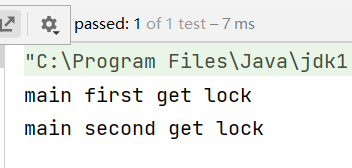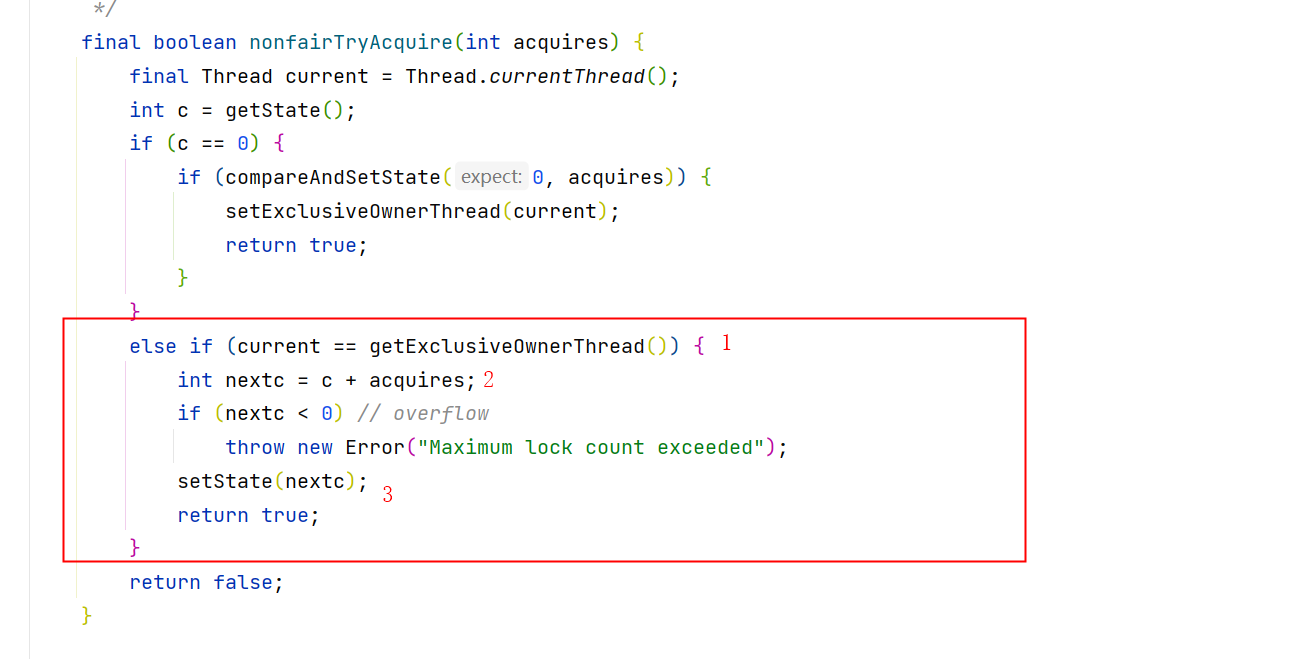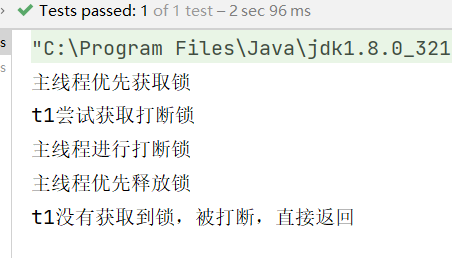概述
前面讲解了 ReentrantLock 加锁和解锁的原理实现,但是没有阐述它的可重入、可打断以及超时获取锁失败的原理,本文就重点讲解这三种情况。建议大家先看下这篇文章了解下 ReentrantLock 加锁的基本原理,图解ReentrantLock公平锁和非公平锁实现。
可重入
可重入是指一个线程如果获取了锁,那么它就是锁的主人,那么它可以再次获取这把锁,这种就是理解为重入,简而言之,可以重复获取同一把锁,不会造成阻塞,举个例子如下:
@Test public void testRepeatLock() { ReentrantLock reentrantLock = new ReentrantLock(); // 第一次获取锁 reentrantLock.lock(); try { System.out.println(Thread.currentThread().getName() + " first get lock"); // 再次获取锁 tryAgainLock(reentrantLock); }finally { reentrantLock.unlock(); } }
public void tryAgainLock(ReentrantLock reentrantLock) { // 第2次获取锁 reentrantLock.lock(); try { System.out.println(Thread.currentThread().getName() + " second get lock"); }finally { reentrantLock.unlock(); } }
复制代码
那你知道是怎么实现的吗?
概述的文章中已经讲解了 ReentrantLock 整个的加锁和解锁的过程,可重入实现就在其中,这里着重关注下申请锁的方法 tryAcquire,最终会调用 nonfairTryAcquire 方法。
如果已经有线程获得了锁, 并且占用锁的线程是当前线程, 表示【发生了锁重入】,上图的 1 步骤
计算出冲入的次数 nextc 等于当前次数+新增次数,acquires 等于 1
更新 state 的值,这里不使用 cas 是因为当前线程正在持有锁,所以这里的操作相当于在一个管程内, 然后返回 ture,表明再次申请锁成功。
可打断
ReentrantLock 相比于 synchronized 加锁一大优势是可打断,那么什么是可打断呢?ReentrantLock 通过lockInterruptibly()加锁,如果一直获取不到锁,可以通过调用线程的interrupt()提前终止线程。举个例子:
@Test public void testInterrupt() throws InterruptedException { ReentrantLock lock = new ReentrantLock();
// 主线程普通加锁 System.out.println("主线程优先获取锁"); lock.lock(); try { // 创建子线程 Thread t1 = new Thread(() -> { try { System.out.println("t1尝试获取打断锁"); lock.lockInterruptibly(); } catch (InterruptedException e) { System.out.println("t1没有获取到锁,被打断,直接返回"); return; } try { System.out.println("t1成功获取锁"); } finally { System.out.println("t1释放锁"); lock.unlock(); } }, "t1"); t1.start(); Thread.sleep(2000); System.out.println("主线程进行打断锁"); t1.interrupt(); } finally { // 主线程解锁 System.out.println("主线程优先释放锁"); lock.unlock(); } }
复制代码
接下来我们看看它的实现原理。
public void lockInterruptibly() throws InterruptedException { sync.acquireInterruptibly(1);}public final void acquireInterruptibly(int arg) { // 被其他线程打断了直接返回 false if (Thread.interrupted()) throw new InterruptedException(); if (!tryAcquire(arg)) // 没获取到锁,进入这里 doAcquireInterruptibly(arg);}
复制代码
private void doAcquireInterruptibly(int arg) throws InterruptedException { // 封装当前线程,加入到队列中 final Node node = addWaiter(Node.EXCLUSIVE); boolean failed = true; try { // 自旋 for (;;) { // shouldParkAfterFailedAcquire判断是否需要阻塞等待 // parkAndCheckInterrupt方法是阻塞线程,返回true,表示线程被中断了 if (shouldParkAfterFailedAcquire(p, node) && parkAndCheckInterrupt()) // 【在 park 过程中如果被 interrupt 会抛出异常】, 而不会再次进入循环获取锁后才完成打断效果 throw new InterruptedException(); } } finally { // 抛出异常前会进入这里 if (failed) // 取消当前线程的节点 cancelAcquire(node); }}
复制代码
addWaiter将当前线程封装成节点,加入到队列中。
shouldParkAfterFailedAcquire()方法判断如果前一个节点的等待状态时-1,则返回 true,表示当前线程需要阻塞。
parkAndCheckInterrupt()方法是阻塞线程,返回 true,表示线程被中断了,抛出InterruptedException异常。
最后调用cancelAcquire()方法,将当前节点状态设置为 cancel 取消状态。
// 取消节点出队的逻辑private void cancelAcquire(Node node) { // 判空 if (node == null) return; // 把当前节点封装的 Thread 置为空 node.thread = null; // 获取当前取消的 node 的前驱节点 Node pred = node.prev; // 前驱节点也被取消了,循环找到前面最近的没被取消的节点 while (pred.waitStatus > 0) node.prev = pred = pred.prev; // 获取前驱节点的后继节点,可能是当前 node,也可能是 waitStatus > 0 的节点 Node predNext = pred.next; // 把当前节点的状态设置为 【取消状态 1】 node.waitStatus = Node.CANCELLED; // 条件成立说明当前节点是尾节点,把当前节点的前驱节点设置为尾节点 if (node == tail && compareAndSetTail(node, pred)) { // 把前驱节点的后继节点置空,这里直接把所有的取消节点出队 compareAndSetNext(pred, predNext, null); } else { // 说明当前节点不是 tail 节点 int ws; // 条件一成立说明当前节点不是 head.next 节点 if (pred != head && // 判断前驱节点的状态是不是 -1,不成立说明前驱状态可能是 0 或者刚被其他线程取消排队了 ((ws = pred.waitStatus) == Node.SIGNAL || // 如果状态不是 -1,设置前驱节点的状态为 -1 (ws <= 0 && compareAndSetWaitStatus(pred, ws, Node.SIGNAL))) && // 前驱节点的线程不为null pred.thread != null) { Node next = node.next; // 当前节点的后继节点是正常节点 if (next != null && next.waitStatus <= 0) // 把 前驱节点的后继节点 设置为 当前节点的后继节点,【从队列中删除了当前节点】 compareAndSetNext(pred, predNext, next); } else { // 当前节点是 head.next 节点,唤醒当前节点的后继节点 unparkSuccessor(node); } node.next = node; // help GC }}
复制代码
锁超时
ReentrantLock 还具备锁超时的能力,调用 tryLock(long timeout, TimeUnit unit)方法,在给定时间内获取锁,获取不到就退出,这也是 synchronized 没有的功能。
@Test public void testLockTimeout() throws InterruptedException { ReentrantLock lock = new ReentrantLock(); Thread t1 = new Thread(() -> { try { // 调用tryLock获取锁 if (!lock.tryLock(2, TimeUnit.SECONDS)) { System.out.println("t1获取不到锁"); return; } } catch (InterruptedException e) { System.out.println("t1被打断,获取不到锁"); return; } try { System.out.println("t1获取到锁"); } finally { lock.unlock(); } }, "t1"); // 主线程加锁 lock.lock(); System.out.println("主线程获取到锁");
t1.start(); Thread.sleep(3000); try { System.out.println("主线程释放了锁"); } finally { lock.unlock(); } }
复制代码
那这个原理实现是什么样的呢?
public boolean tryLock(long timeout, TimeUnit unit) throws InterruptedException { // 调用tryAcquireNanos方法 return sync.tryAcquireNanos(1, unit.toNanos(timeout));}
public final boolean tryAcquireNanos(int arg, long nanosTimeout) { if (Thread.interrupted()) throw new InterruptedException(); // tryAcquire 尝试一次,获取不到的话调用doAcquireNanos方法 return tryAcquire(arg) || doAcquireNanos(arg, nanosTimeout);}
protected final boolean tryAcquire(int acquires) { return nonfairTryAcquire(acquires);}
复制代码
private boolean doAcquireNanos(int arg, long nanosTimeout) { if (nanosTimeout <= 0L) return false; // 获取最后期限的时间戳 final long deadline = System.nanoTime() + nanosTimeout; // 将当前线程添加到队列中 final Node node = addWaiter(Node.EXCLUSIVE); boolean failed = true; try { // 自旋 for (;;) { // 获取前驱节点 final Node p = node.predecessor(); // 前驱节点是head,尝试获取锁 if (p == head && tryAcquire(arg)) { setHead(node); p.next = null; // help GC failed = false; return true; } // 计算还需等待的时间 nanosTimeout = deadline - System.nanoTime(); if (nanosTimeout <= 0L) //时间已到 return false; if (shouldParkAfterFailedAcquire(p, node) && // 如果 nanosTimeout 大于该值,才有阻塞的意义,否则直接自旋会好点 nanosTimeout > spinForTimeoutThreshold) LockSupport.parkNanos(this, nanosTimeout); // 【被打断会报异常】 if (Thread.interrupted()) throw new InterruptedException(); } }}
复制代码
总结
本文主要从使用到原理讲解了 ReentrantLock 锁的可重入、可打断和锁超时的特性,希望对大家有帮助。















评论